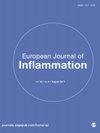侵袭性和定植性肠球菌毒力因子基因、β-溶血和生物膜产生的比较研究
IF 0.6
4区 医学
Q4 IMMUNOLOGY
引用次数: 0
摘要
目的:在人类中,肠球菌是最重要的机会性病原体之一。本研究旨在比较从败血症和心内膜炎患者的血液培养中获得的侵袭性分离株与从健康捐赠者粪便样本中获得的定植性分离株。方法:对侵袭性感染病例进行个案评估,以确定肠球菌是否参与了其发病机制。他们测试了毒力因子基因的存在、补充人血和羊血的琼脂的β-溶血作用以及生物膜形成能力。结果:在入侵分离株中鉴定出三种肠球菌:粪肠球菌、粪肠球菌和硬脑膜肠球菌。所有的心内膜炎分离物都是生物膜产生者。esp基因、gelE基因、asa1基因、ace基因、hyl基因、cylB基因和cylA基因分别存在于7个(41.2%)、11个(64.7%)、11(64.7%,13个(76.5%)、0个、3个(17.6%)和1个(5.9%)侵袭性分离株中,但它们都与特定感染(败血症或心内膜炎)无关。菌落分离株被证明具有更多的毒力因子基因,但差异无统计学意义。当ace基因缺失时,该组成员产生了更多的生物膜(p=0.047)。当琼脂补充人血时,非侵入性菌株产生β-溶血的频率更高(p=0.021)。一般来说,cyl基因在该特异性琼脂上的存在与β-溶血的产生直接相关:cylA(p=0.047)或cylB(p=0.020)。结论:我们无法确定侵袭性分离株与任何毒力基因携带和生物膜形成之间的任何相关性。当琼脂补充人血时,定植菌株更容易产生β溶血。本文章由计算机程序翻译,如有差异,请以英文原文为准。
Comparative study of virulence factor genes, β-hemolysis and biofilm production in invasive and colonizing enterococci
Objectives: In humans, enterococci are among the most important opportunistic pathogens. This study aims to compare invasive isolates obtained from blood cultures of patients with sepsis and endocarditis with colonizing isolates obtained from healthy donors’ stool samples. Methods: A case-by-case assessment was conducted on invasive infection cases to determine whether enterococci were involved in their pathogenesis. They were tested for the presence of virulence factor genes, β-hemolysis on agars supplemented with human and sheep blood, and biofilm forming capacity. Results: Three species of enterococci were identified among invasive isolates: Enterococcus faecalis, Enterococcus faecium, and Enterococcus durans. All endocarditis isolates were biofilm producers. Genes esp, gelE, asa1, ace, hyl, cylB, and cylA were present in 7 (41.2%), 11 (64.7%), 11 (64.7%), 13 (76.5%), 0, 3 (17.6%), and 1 (5.9%) invasive isolate, but none of them could be linked to a particular infection (sepsis or endocarditis). Colonizing isolates proved to have had more virulence factor genes, but the differences were not statistically significant. Members of that group produced a greater amount of biofilm when the ace gene was absent ( p = 0.047). The production of β-hemolysis by noninvasive strains was detected more frequently when agar was supplemented with human blood ( p = 0.021). In general, the presence of either cyl gene on that specific agar was in direct connection with the production of β-hemolysis: cylA ( p = 0.047) or cylB ( p = 0.020). Conclusion: We have been unable to establish any correlation between invasive isolates and any virulence gene carriage and biofilm formation. β-hemolysis was produced significantly more often by colonizing strains when agar had been supplemented with human blood.
求助全文
通过发布文献求助,成功后即可免费获取论文全文。
去求助
来源期刊
CiteScore
0.90
自引率
0.00%
发文量
54
审稿时长
15 weeks
期刊介绍:
European Journal of Inflammation is a multidisciplinary, peer-reviewed, open access journal covering a wide range of topics in inflammation, including immunology, pathology, pharmacology and related general experimental and clinical research.

 求助内容:
求助内容: 应助结果提醒方式:
应助结果提醒方式:


